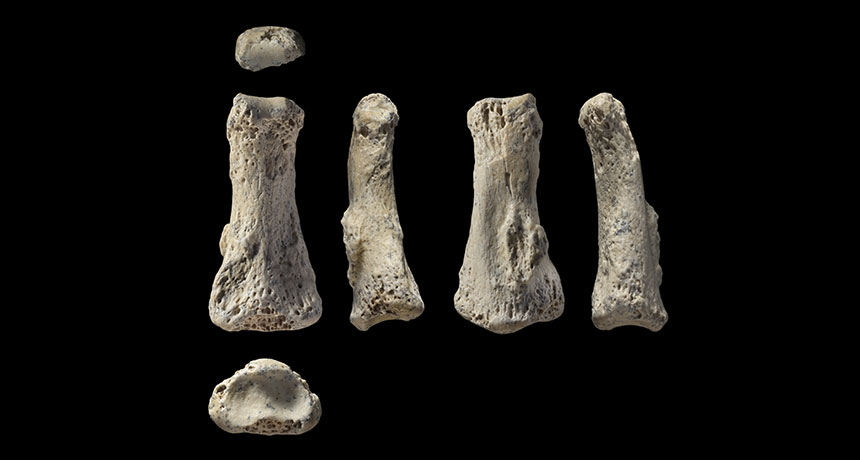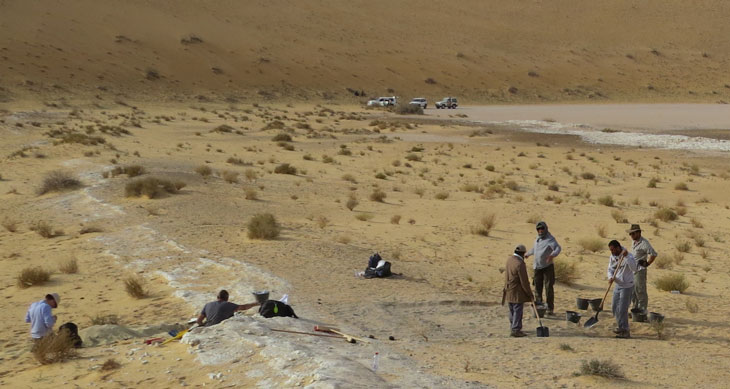Finger fossil puts people in Arabia at least 86,000 years ago
A desert discovery builds the case for humans’ early departure from Africa

ARABIAN POINTER A human finger fossil found in a Saudi Arabian desert dates to between 95,000 and 86,000 years ago, researchers say. This find, shown here from different angles, strengthens the view that ancient humans expanded into Asia via Arabia.
Ian Cartwright
A single human finger bone from at least 86,000 years ago points to Arabia as a key destination for Stone Age excursions out of Africa that allowed people to rapidly spread across Asia.
Excavations at Al Wusta, a site in Saudi Arabia’s Nefud desert, produced this diminutive discovery. It’s the oldest known Homo sapiens fossil outside of Africa and the narrow strip of the Middle East that joins Africa with Asia, based on dating of the bone itself, says a team led by archaeologists Huw Groucutt and Michael Petraglia. This new find strengthens the idea that early human dispersals out of Africa began well before the traditional estimated departure time of 60,000 years ago and extended deep into Arabia, the scientists report April 9 in Nature Ecology & Evolution.
“Although long considered to be far from the main stage of human evolution, Arabia was a stepping stone from Africa into Asia,” says Petraglia, of the Max Planck Institute for the Science of Human History in Jena, Germany.
Don’t be misled by the vast deserts that dominate the Arabian Peninsula today. Geologic evidence indicates that Al Wusta lay within a well-watered, human-friendly area between around 95,000 and 86,000 years ago, the estimated age range for the human finger fossil, Groucutt and Petraglia’s team says. Dating relied on measures of the decay of a radioactive form of uranium in the human fossil and a nearby hippo tooth. Those results were combined with a measure of exposure to natural doses of radiation in the tooth. Another technique estimated the time since the finger bone and adjacent finds were buried by sediment.

The 2016 Al Wusta find is probably the middle bone from an adult’s middle finger, suspects Groucutt, of the University of Oxford. It’s unclear whether the bone came from a man or a woman, or from a right or left hand.
It’s definitely human, though. To establish the fossil’s identity, the researchers compared a 3-D image of the ancient finger bone with corresponding bones of present-day people, apes and monkeys, as well as Neandertals and other ancient hominids.
The newly discovered fossil fits into a rough timeline of Stone Age human departures from Africa. H. sapiens reached what’s now Israel as early as 194,000 years ago (SN: 2/17/18, p. 6) and East Asia by at least 80,000 years ago (SN: 11/14/15, p. 15). Humans arrived in Indonesia (SN Online: 8/9/17) and Australia (SN: 8/19/17, p. 10) shortly before 60,000 years ago.
How humans moved into Arabia is uncertain. Along with the finger, Al Wusta yielded 380 stone tools and 860 nonhuman animal fossils from the same time. Some of those animals, including hippos and gazelles, originated in Africa and no longer inhabit the Arabian Peninsula. Ancient groups of hunter-gatherers followed these grazing animals from North Africa into Arabia as climate fluctuations periodically turned deserts into grasslands with lakes and rivers, Petraglia proposes. When those landscapes dried out every 20,000 years or so, people could have returned to Africa or headed farther into Asia.
Al Wusta’s ancient human fossil — combined with comparably ancient stone tools found at other Arabian Peninsula sites (SN: 4/4/15, p. 16) — challenges the view that humans left Africa in one or a few major migrations, says paleoanthropologist María Martinόn-Torres. Instead, small groups of African H. sapiens continually traveled into Arabia and beyond starting nearly 100,000 years ago or earlier, suggests Martinόn-Torres, who directs the National Research Center on Human Evolution in Burgos, Spain. Periods of increased rainfall may have provided “windows of opportunity” for human movements into Arabia, she adds.
Al Wusta stone tools differ in some ways from those at slightly older sites in Israel. Paleoanthropologist Donald Henry of the University of Tulsa in Oklahoma interprets those differences to mean culturally distinct African populations took a southern route into Arabia. To reach Al Wusta, East African travelers could have crossed a narrow sea channel from the Horn of Africa to Arabia’s southwestern corner before heading up to Al Wusta, Henry suggests in a comment published with the new report.
Petraglia doubts that scenario. Ancient humans could easily have followed grazing animals up the Nile River Valley into the Middle East and then south into Arabia, he says, adjusting their tools to new settings along the way.







